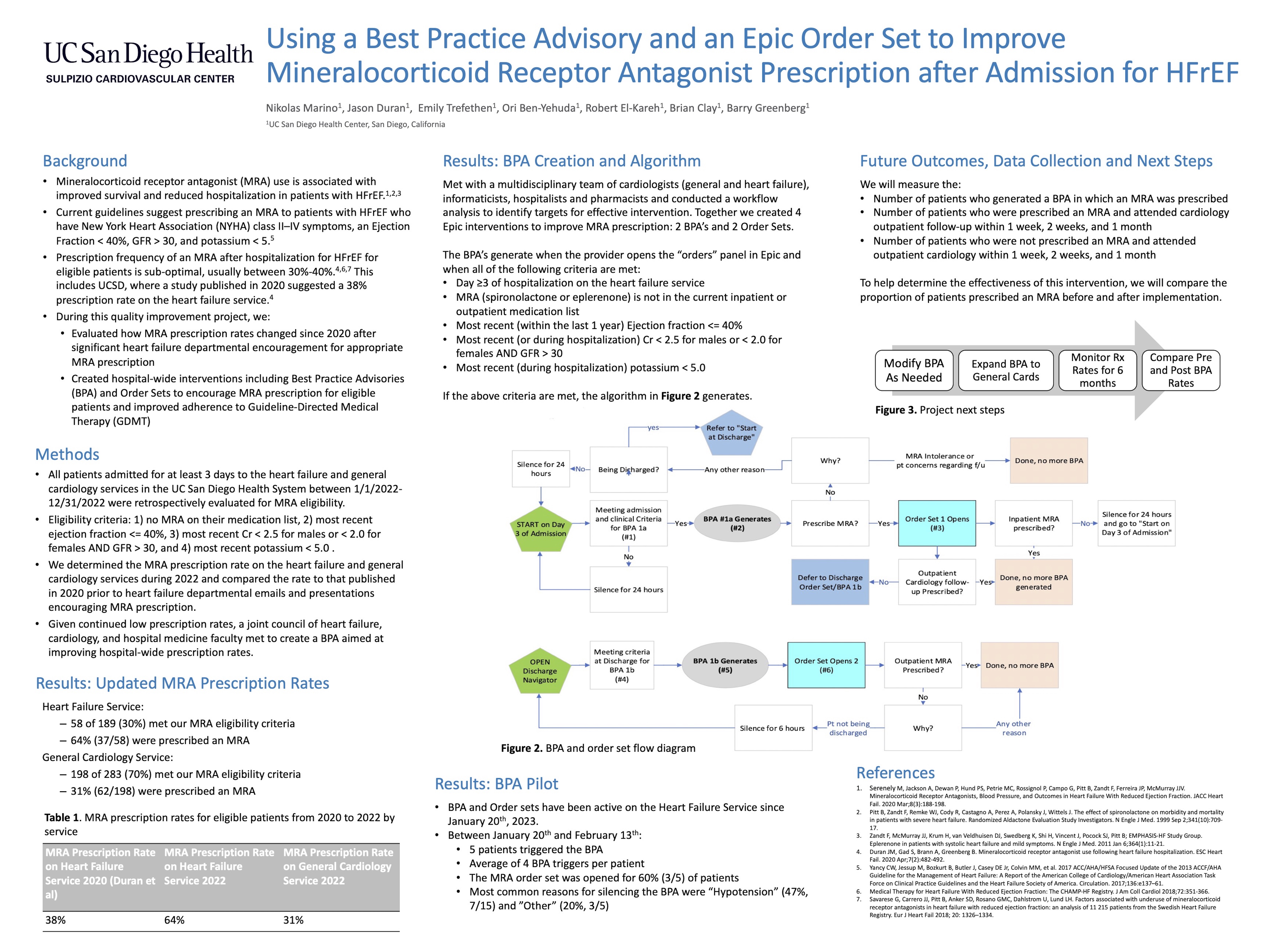Using a Best Practice Advisory and an Epic Order Set to Improve Mineralocorticoid Receptor Antagonist Prescription after Admission for HFrEF
Abstract
Introduction:
Mineralocorticoid receptor antagonist (MRA) therapy improves survival in patients with Heart Failure with Reduced Ejection Fraction (HFrEF) and is recommended by heart failure guidelines. Prescription rates of MRA therapy after hospitalization for HFrEF for eligible patients are sub-optimal, usually between 30%-40%. A 2020 study from UC San Diego showed that only 38% of eligible HFrEF patients on the heart failure service were prescribed an MRA after hospitalization. Since this 2020 publication, UC San Diego’s heart failure team has strongly encouraged increased prescription of MRA therapy through departmental presentations and email reminders. In this study, we evaluate the impact of this encouragement on MRA prescription at UC San Diego. We have also created new interventions to further improve hospital-wide MRA prescription, including Best Practice Advisories (BPA) and an order sets.
Methods:
All patients admitted for at least 3 days to the heart failure and general cardiology services in the UC San Diego Health System between 1/1/2022-12/31/2022 were retrospectively evaluated for MRA eligibility. Patients were eligible if there was no MRA on their medication list, the most recent ejection fraction <=40%, most recent Cr < 2.5 for males or < 2.0 for females AND GFR >30, and most recent potassium < 5.0. We determined the MRA prescription rate between 1/1/2022-12/31/2022 after initial presentations and email interventions, then compared this to rates in the 2020 publication. Given continued low prescription rates, a joint council of heart failure, cardiology, and hospital medicine faculty met to create a BPA aimed at improving hospital-wide prescription rates.
Results:
From 1/1/2022-12/31/2022, 189 patients with an EF<40% were admitted to the heart failure service. Only 58 of these 198 (30%) met our MRA eligibility criteria. About 64% (37/58) were prescribed an MRA compared to 38% reported in the 2020 UC San Diego publication. During this same time period, 198 patients on the general cardiology service met our MRA eligibility criteria. Only 31% (62/198) were prescribed an MRA. To address persistently low prescription rates, we created a BPA to remind providers to prescribe MRA therapy to eligible patients. The BPA generates inside of the “orders” panel in Epic if all of the above MRA eligibility criteria are met. If the provider accepts the BPA, an order set opens to suggest MRA dosages and Cardiology outpatient follow-up. These interventions were first implemented on the cardiology services in January 2023 with a plan to expand them to hospital medicine by the end of 2023. We will compare MRA prescription rates for the 6 months prior to and 6 months following BPA implementation.
Conclusions
Recent MRA prescription rates on the heart failure service significantly improved compared to rates reported in the 2020 UC San Diego publication after strong department encouragement. Despite this encouragement, 36% of eligible patients on the heart failure service and almost 70% on the general cardiology service are not being prescribed an MRA. We created BPA and order set interventions that were recently implemented on the Cardiology services that we believe will increase MRA prescription rates in the inpatient setting.


